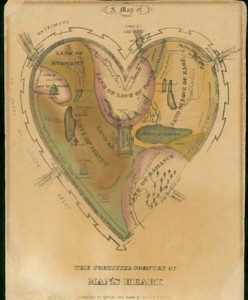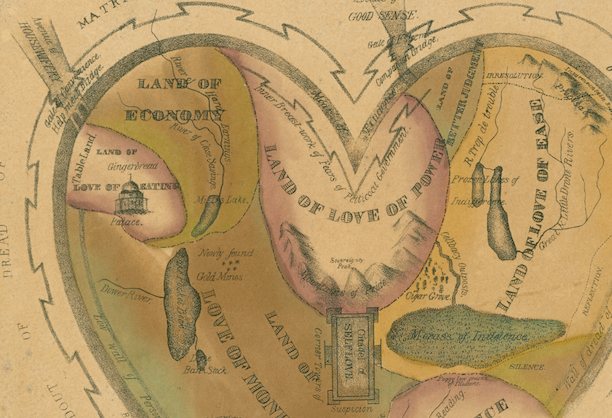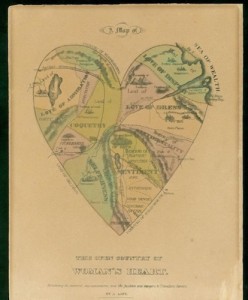By Nancy Finlay for Your Pubic Media
A pair of 19th-century prints provides a virtual road map to the human heart, illustrating contemporary male and female attitudes towards courtship and love.
A Map of the Open Country of Woman’s Heart shows canals, rivers, roads, and a railroad connecting the Country of Eligibleness with the City and District of Love. Coquetry, Caprice, and Selfishness lead to the Land of Oblivion. Love of Dress and Love of Display lead to Old Man’s Darling Bay on the Sea of Wealth. And Good Sense, Discrimination, Patience, Hope, and Enthusiasm are the way to the Country of Solid Worth. A multitude of details provides additional commentary on the different options available to an eligible young woman—and the different choices she might choose to make.
In contrast, the Fortified Country of Man’s Heart is portrayed as a citadel, bristling with defenses intended to ward off attack. The outer redoubt is the Dread of Matrimony; at the center is the Citadel of Self Love. Much of the country appears inhospitable to romance, with such regions as the Land of Love of Power, the Land of Love of Money, the Land of Love of Ease, and the Land of Love of Economy. The Land of Romance occupies only one small corner of Man’s Heart.
D.W. Kellogg & Co. Prints Invite Speculation

A Map of the Fortified Country of Man’s Heart. Hand-colored lithograph, 1830s. Printed and published by D.W. Kellogg & Co., based on a composition by “A Lady.” – Connecticut Historical Society
Published sometime during the 1830s by D.W. Kellogg & Co. of Hartford, both prints are identified only as the compositions of “a Lady.” The identity of this clever and talented woman is unknown, but it is tempting to speculate that she might have been the sweetheart or wife of one of Daniel Kellogg’s two younger brothers, possibly Nancy Avery, whom Edmund Kellogg married in 1838. Elijah, the youngest of the brothers, did not marry until 1846. It is also possible that the artist was actually a man, who adopted this pseudonym because the prints appear to reflect a feminine sensibility and seem calculated to appeal to female purchasers.
Nancy Finlay, formerly Curator of Graphics at the Connecticut Historical Society, is the editor of Picturing Victorian America: Prints by the Kellogg Brothers of Hartford, Connecticut, 1830-1880.
© Connecticut Public Broadcasting Network and Connecticut Historical Society. All rights reserved. This article originally appeared on Your Public Media
Note: ConnecticutHistory.org does not edit content originally published on another platform and therefore does not update any instances of outdated content or language.










